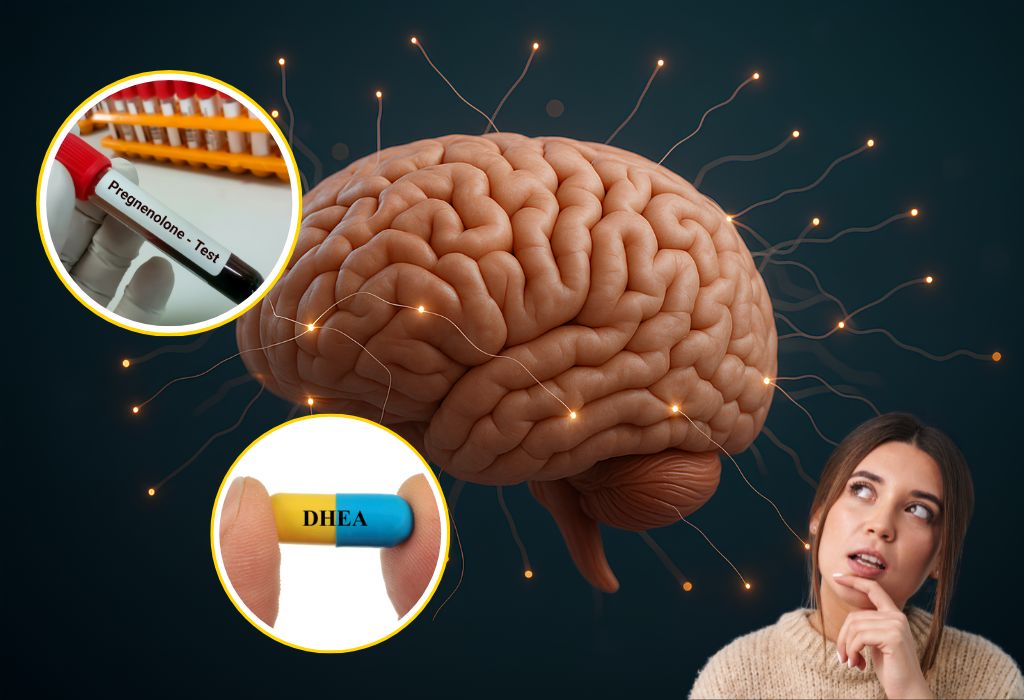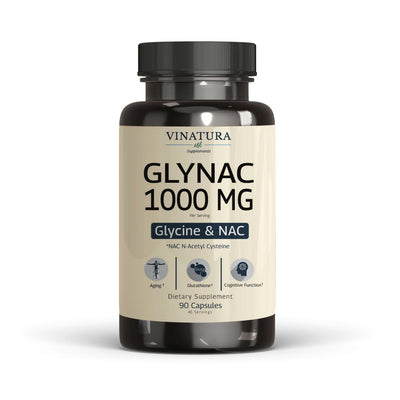
Can I Take Pregnenolone and DHEA Together?
Pregnenolone and DHEA can be taken together, but proper dosage and timing are essential. These hormone precursors influence neuroendocrine function and may offer combined benefits for mood, memory, and overall well-being.
However, taking them without guidance may lead to hormonal imbalances or unwanted side effects. Research suggests potential synergy, especially in the 200–400 mg range, but individual needs vary.
For safety and effectiveness, it’s important to consult a healthcare provider before combining these supplements.
Before exploring further, please read the disclaimer located at the end of this webpage.
Key Takeaways
- DHEA and pregnenolone are both steroid hormone precursors, each with distinct physiological functions.
- Emerging scientific evidence suggests potential benefits when used together, particularly for adrenal fatigue, cognitive enhancement, and anti-aging applications.
- Dosage, ratio, and interaction risks must be carefully evaluated.
- Co-supplementation should always be done under professional medical supervision.
What is DHEA?
DHEA (Dehydroepiandrosterone) is an endogenous steroid hormone primarily produced by the adrenal glands via the cholesterol synthesis pathway. It acts as a vital precursor for the biosynthesis of several key sex hormones, including androgens (such as testosterone) and estrogens (such as estradiol).

The body begins to produce DHEA in early childhood, with levels increasing after the age of 7, peaking during late adolescence and early adulthood (approximately between the ages of 20 to 24).
After this peak, DHEA levels decline steadily with age—at an estimated rate of 20% per decade. This means that if your DHEA level is 100% at age 25, by the time you reach 65, it may drop to approximately 20%, leading to symptoms associated with aging, such as fatigue, reduced cognitive performance, and diminished libido(Baulieu et al., 2000).
In addition to age-related decline, DHEA levels are also adversely affected by external stressors such as physiological stress, trauma, or infection. This makes declining DHEA a growing concern in the context of today’s demanding lifestyle.
The Role of DHEA in Hormone and Human Health
DHEA is primarily synthesized by the adrenal cortex, with smaller amounts produced by the ovaries in women and the testes in men.
Unlike systemic (endocrine) hormones that travel through the bloodstream, DHEA functions predominantly in a local (intracrine) manner—being converted and acting within specific tissues such as the brain, skin, and adipose tissue. Therefore, serum DHEA levels often fail to capture the full spectrum of its biological activity(Labrie et al., 2005).
The diagram below illustrates DHEA’s metabolic pathway, helping to clarify its role in hormone synthesis and physiological impact:

DHEA plays a critical role in maintaining endocrine homeostasis, particularly in aging individuals whose natural hormone production begins to wane. Several studies have demonstrated that DHEA supplementation can improve both physical and psychological health markers.
These include increases in muscle strength, bone density, and reductions in age-related fat accumulation and skin atrophy. It has also been shown to stimulate the production of procollagen and sebum (Rutkowski et al., 2014).
However, due to its potent hormonal activity, improper supplementation can lead to undesirable side effects, such as oily skin, hirsutism, or mood alterations—especially in the absence of professional medical oversight.
DHEA is also associated with improved reproductive function in women. For example, one clinical study reported that DHEA supplementation enhanced pregnancy rates and reduced miscarriage incidence among women with diminished ovarian reserve.
In this study, among 109 infertile women aged 36–40 undergoing IVF, the DHEA group showed a significantly higher live birth rate compared to the control group(Massimo Tartagni, et al. 2015).
However, the study, despite its promising results, was limited by its small sample size, unrepresentative subjects, and lack of clarity about the study design. Therefore, larger, well-controlled clinical trials are needed to confirm the true effects of DHEA on fertility.
You may also like: Is Combining DHEA And Tongkat Ali Together A Good Idea?
What is Pregnenolone?
Pregnenolone—often referred to as the “mother hormone”—is the precursor to many other steroid hormones. Like DHEA, pregnenolone is synthesized from cholesterol, primarily within the mitochondria of the adrenal glands. However, it is also produced in smaller amounts in the brain, skin, liver, ovaries (in females), and testes (in males).

Pregnenolone is the origin of many important hormones such as progesterone, cortisol, estrogen, and testosterone. Similar to DHEA, pregnenolone levels decline over time.
Specifically, pregnenolone sulfate levels in women peak around the age of 32 and then steadily decrease, whereas in men, the peak occurs about five years earlier and then remains relatively stable(Helena et al., 2002) .
Furthermore, pregnenolone is associated with memory, concentration, responsiveness, and interaction with stress. For example, pregnenolone and its derivatives, such as pregnenolone sulfate, improve memory and learning ability in animal models.
These compounds influence neuroplasticity and enhance signaling through GABA and glutamate — two major neurotransmitter systems (Baulieu et al., 2000).
Moreover, pregnenolone sulfate has been shown to reduce anxiety-like behavior and increase adaptability under stressful conditions by modulating the GABAergic and glutamatergic systems (Darbra et al., 2009).
This is mainly because pregnenolone is found at higher concentrations in the central nervous system compared to peripheral tissues, highlighting its importance to brain function.
Therefore, changes in pregnenolone levels have the potential to affect these brain functions. For this reason, more specific studies are needed to accurately assess pregnenolone’s effects.
However, most existing evidence is based on animal models, and well-designed clinical trials in humans are needed to confirm the cognitive benefits and safety profile of pregnenolone.
The Role of Pregnenolone in Hormone and Human Health
To fully understand pregnenolone’s importance, one must recognize it as the first steroid hormone derived from cholesterol—a conversion that occurs mainly in the mitochondria, appearing in the adrenal glands, brain, testes, ovaries, and placenta (Miller, et al. 2013).
This biosynthetic step is catalyzed by the mitochondrial enzyme CYP11A1 (cholesterol side-chain cleavage enzyme), converting cholesterol into pregnenolone. From there, pregnenolone undergoes multiple metabolic pathways to generate:
- Glucocorticoids (e.g., cortisol)
- Mineralocorticoids (e.g., aldosterone)
- Androgens (e.g., DHEA, testosterone)
- Estrogens (e.g., estradiol, estrone)
- Progesterone, a hormone critical for menstrual function and pregnancy

Pregnenolone also interacts with neurotransmitter receptors such as GABA and NMDA, suggesting a neuromodulatory role in cognitive adaptation. Studies indicate that pregnenolone may enhance sleep quality, regulate circadian rhythms, and reduce sleep disturbances(Teran-Perez et al., 2012).
In addition, pregnenolone also has the potential to support neuroprotection; it is involved in disorders related to stress, anxiety, as well as in addiction processes that significantly impact cannabinoid-related disorders (Vallee et al., 2016).
This means that pregnenolone has a certain effect on protecting and maintaining healthy and normal neurological functions in adults.
Moreover, Animal studies have examined how pregnenolone may influence brain function, with some findings pointing to possible relevance in areas related to mental health, including schizophrenia (Marx et al., 2011); however, these remain preliminary findings that require validation through large-scale clinical trials before any firm conclusions can be drawn.
Can I Take Pregnenolone and DHEA Together?

The short answer is yes—pregnenolone and DHEA can be taken together under appropriate conditions. However, the dosage, ratio, and timing of administration are critical variables that must be managed carefully. Unlike nutritional supplements, these are potent hormonal precursors, and improper use can lead to adverse outcomes.
In studies, the dosage of DHEA and pregnenolone typically ranges around 400 mg per day. For example, a study investigating the combined effects of these two compounds on stress response and emotions used a similar dosage and observed positive differences after the study period (Rebecca K. et al., 2013).
Another study using a comparable dosage demonstrated support for improved cognitive functions, while a 200 mg dose of DHEA did not provide significant benefits (Ritsner et al., 2010).
Therefore, the dosage range of 200–400 mg for each compound should be considered. However, the exact dosage should be advised by healthcare professionals and follow the recommendations of product manufacturers combining these substances.
Overuse or mismanagement may result in hormonal dominance (e.g., estrogen or testosterone excess), leading to endocrine disorders such as hormonal imbalances, development of secondary sexual characteristics inappropriate for one’s sex, and potential drug interactions.
Additionally, through a discussion thread on Reddit titled “Pregnenolone/DHEA side effects,” users shared experiencing symptoms such as fatigue and brain fog. Meanwhile, another user reported having difficulty sleeping for several consecutive months along with brain fog.*
Therefore, consulting with healthcare professionals is necessary in such cases to be aware of and adequately prepare for potential side effects. For these reasons, medical supervision is strongly recommended.
Despite these risks, combining pregnenolone and DHEA may offer synergistic benefits, especially for purposes such as adrenal support, cognitive enhancement, and healthy aging.
Since both hormones originate from cholesterol metabolism and influence neurological and endocrine function, their combined use—when carefully balanced—can provide enhanced physiological effects.
To better understand this combination, we will now explore what the scientific literature reveals about these two powerful hormone precursors.
What Does Science Say About Pregnenolone and DHEA in Cognitive and Anti-Aging Health?
To better evaluate the potential of combining pregnenolone and DHEA, let’s examine what scientific research reveals:
In a study exploring adjunctive therapies for schizophrenia and schizoaffective disorders, an 8-week clinical trial investigated the use of pregnenolone (at 30 mg and 200 mg/day) and DHEA (400 mg/day).
Results showed that low-dose pregnenolone (30 mg/day) significantly reduced positive symptoms and improved working memory, while DHEA supplementation alleviated extrapyramidal side effects associated with antipsychotic medications (Ritsner et al., 2010) [12].
Furthermore, a cross-sectional study involving 122 healthy adults found a positive correlation between serum pregnenolone levels and both working memory and verbal fluency in men.
Additionally, DHEA and its sulfated form (DHEA-S) were associated with improved quality of life and cognitive function, particularly in males—highlighting the essential role of these neurosteroids in preserving cognitive health and psychological well-being (Chen et al., 2018) [14].
However, further clinical evidence and controlled studies are warranted to establish the optimal dosage, safety, and efficacy for the above effects.
Testimonial Disclaimer
*The testimonials presented on this website are provided by individuals based on their personal experiences with our products. These testimonials represent individual opinions and experiences, which may not be typical or applicable to all users of our products. Results may vary depending on a variety of factors, including individual health, lifestyle, and adherence to product usage instructions.Conclusion
In conclusion, the combination of pregnenolone and DHEA presents a promising strategy for individuals seeking to optimize cognitive performance, support anti-aging efforts, and restore hormonal balance.
However, such interventions must be highly individualized, guided by scientific evidence, and carried out under medical supervision, including appropriate lab testing and a thorough understanding of potential contraindications.
It’s critical to acknowledge that these hormones are not “magic pills.” Yet, when used responsibly and appropriately, pregnenolone and DHEA can serve as powerful tools for enhancing brain health, mental clarity, and endocrine function—regardless of gender.
References
- [1] [6] Etienne-Emile Baulieu, et al. “Dehydroepiandrosterone (DHEA), DHEA Sulfate, and Aging: Contribution of the DHEAge Study to a Sociobiomedical Issue.” Proceedings of the National Academy of Sciences, vol. 97, no. 8, National Academy of Sciences, Apr. 2000, pp. 4279–84, https://doi.org/10.1073/pnas.97.8.4279.
- [2] Labrie, F., et al. “Is Dehydroepiandrosterone a Hormone?” Journal of Endocrinology, vol. 187, no. 2, Bioscientifica, Nov. 2005, pp. 169–96, https://doi.org/10.1677/joe.1.06264.
- [3] Rutkowski, Krzysztof, et al. “Dehydroepiandrosterone (DHEA): Hypes and Hopes.” Drugs, vol. 74, no. 11, Springer Science and Business Media LLC, July 2014, pp. 1195–207, https://doi.org/10.1007/s40265-014-0259-8.
- [4] Massimo Tartagni, et al. “Dehydroepiandrosterone Decreases the Age-Related Decline of the in Vitro Fertilization Outcome in Women Younger than 40 Years Old.” Reproductive Biology and Endocrinology, vol. 13, no. 1, BioMed Central, Mar. 2015, https://doi.org/10.1186/s12958-015-0014-3.
- [5] Havlíková Helena, et al. “Sex- and Age-Related Changes in Epitestosterone in Relation to Pregnenolone Sulfate and Testosterone in Normal Subjects.” The Journal of Clinical Endocrinology & Metabolism, vol. 87, no. 5, The Endocrine Society, May 2002, pp. 2225–31, https://doi.org/10.1210/jcem.87.5.8499.
- [6] Sònia Darbra, and Marc Pallarès. “Neonatal Allopregnanolone Increases Novelty‐Directed Locomotion and Disrupts Behavioural Responses to GABAA Receptor Modulators in Adulthood.” International Journal of Developmental Neuroscience, vol. 27, no. 6, Wiley, May 2009, pp. 617–25, https://doi.org/10.1016/j.ijdevneu.2009.05.008.
- [7] Miller, Walter L. “Steroid Hormone Synthesis in Mitochondria.” Molecular and Cellular Endocrinology, vol. 379, no. 1-2, Elsevier BV, Apr. 2013, pp. 62–73, https://doi.org/10.1016/j.mce.2013.04.014.
- [8] G. Teran-Perez, et al. “Steroid Hormones and Sleep Regulation.” Mini-Reviews in Medicinal Chemistry, vol. 12, no. 11, Bentham Science Publishers, Sept. 2012, pp. 1040–48, https://doi.org/10.2174/138955712802762167.
- [9] Vallée, Monique. “Neurosteroids and Potential Therapeutics: Focus on Pregnenolone.” The Journal of Steroid Biochemistry and Molecular Biology, vol. 160, Elsevier BV, June 2016, pp. 78–87, https://doi.org/10.1016/j.jsbmb.2015.09.030.
- [10] Marx, C. E., et al. “Pregnenolone as a Novel Therapeutic Candidate in Schizophrenia: Emerging Preclinical and Clinical Evidence.” Neuroscience, vol. 191, Elsevier BV, Sept. 2011, pp. 78–90, https://doi.org/10.1016/j.neuroscience.2011.06.076.
- [11] Sripada, Rebecca K., et al. “The Neurosteroids Allopregnanolone and Dehydroepiandrosterone Modulate Resting-State Amygdala Connectivity.” Human Brain Mapping, vol. 35, no. 7, Wiley, Dec. 2013, pp. 3249–61, https://doi.org/10.1002/hbm.22399.
- [12] [13] Ritsner, Michael S., et al. “Pregnenolone and Dehydroepiandrosterone as an Adjunctive Treatment in Schizophrenia and Schizoaffective Disorder.” The Journal of Clinical Psychiatry, vol. 71, no. 10, Physicians Postgraduate Press, Inc., June 2010, pp. 1351–62, https://doi.org/10.4088/jcp.09m05031yel.
- Ritsner, Michael S., et al. “Pregnenolone and Dehydroepiandrosterone as an Adjunctive Treatment in Schizophrenia and Schizoaffective Disorder.” The Journal of Clinical Psychiatry, vol. 71, no. 10, Physicians Postgraduate Press, Inc., June 2010, pp. 1351–62, https://doi.org/10.4088/jcp.09m05031yel.
- [14] Chen, Chien-Yu, et al. “Gender Differences in the Relationships among Neurosteroid Serum Levels, Cognitive Function, and Quality of Life.” Neuropsychiatric Disease and Treatment, vol. Volume 14, Informa UK Limited, Sept. 2018, pp. 2389–99, https://doi.org/10.2147/ndt.s176047.
Author

Product Disclaimer
Including an ingredient or study does not evaluate, endorse, or recommend any Vinatura product or any third-party product. Some ingredients discussed may not be used in any Vinatura product.
The content of the articles has not been evaluated by the Food and Drug Administration (FDA) and is not intended to promote or endorse any specific product. Any products sold on this website are not intended to diagnose, treat, cure, or prevent any disease.
Opinions and Endorsements
Any claims, statements, or opinions expressed in the articles are those of the author(s) and do not necessarily reflect the views or opinions of the manufacturers of the dietary supplement products. The products sold on this website are separate from the content of the articles and are not directly endorsed or associated with the information presented here.
Liability Disclaimer
The author(s) of the articles, website, and manufacturers of the dietary supplement products do not assume any liability for any potential consequences arising from the use of the information provided in the articles. Ingredient effects, dosages, and safety vary by individual, formulation, and context; some ingredients interact with medications or may be unsuitable during pregnancy or lactation. It is recommended that individuals consult with a qualified healthcare professional before making any dietary or lifestyle changes, including the use of dietary supplements.
Product Usage
Please refer to the product labels and packaging for specific usage instructions and guidelines for the dietary supplement products sold on this website.
Customer Support
For any concerns or questions regarding the dietary supplement products, please contact our customer support team, who will be more than happy to assist you.





Leave a Comment
Be the first to comment.
What do you think?